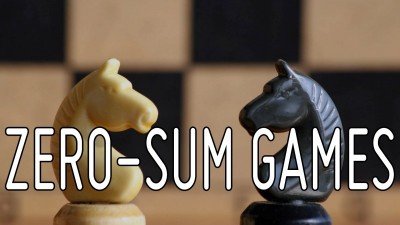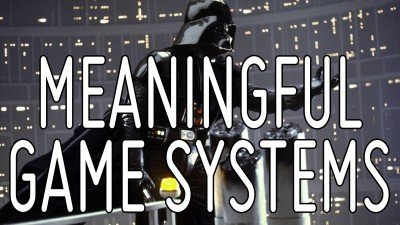Tips on game balancing
Game balancing is key for game design. Finding the exact damage value for a weapon or the correct height for the jump of a character is exciting for game designers because it’s about the only moment where we can immediately see the impact of our decisions.
This feedback loop is so rewarding it can trick us into endless tweaking, tinkering and fiddling of spreadsheets. Focusing so much on details can often make us forget the big picture, and I want to give you my tips on how to approach game balancing.
Game balancing is creating dynamics
The most important notion is that elements of a game are meaningless on their own, as the player will never encounter them in a vacuum. An ability will always be confronted by obstacles. For gameplay to feel good, player tools must seem adapted to the challenge they help overcome.  This lets players develop a consistent understanding of the game and leads to “aha moments” as they recognize patterns in the obstacles and know what ability to use.
This lets players develop a consistent understanding of the game and leads to “aha moments” as they recognize patterns in the obstacles and know what ability to use.
The first level of Super Mario Bros proposes obstacles exactly matched to Mario’s jump, in height and length. This teaches the player the parameters of the key ability, and will allow to clearly evaluate options in navigating each level.
Games are systems of elements in interaction, and a dynamic always emerges from the ensemble. Because you want to give players a seamless experience interacting with your game dynamic, you should decide upon it first, then use this target to evaluate your balancing effort. It is the role of design to determine these interactions, and of game balancing to set parameters so things unfold as desired.
Another way to make a tool particularly adapted to a situation is to make it way more efficient compared to the others. Think of the classic RTS unit type cycle infantry/archer/cavalry, or even rock/paper/scissors. Once again, it is the clarity or the relationship that creates a satisfactory decision for players because it lets them learn more easily.
This illustrates the notion that game balancing is generally not about making the different elements equal, but rather creating strong discrepancies leading to clear dynamics and relationships.
Game theory applied to game balancing

Hearthstone cards get nerfed if used in most decks.
With many moving parts, it is possible that strategies becomes way stronger than expected, to the point of making all other options useless, what game theory calls dominant strategies. If your gameplay relies on selecting the best approach, this will definitely hurt the depth of the decision process as well as gameplay variety.
In this case, you want to reduce the effectiveness of the elements that give so much strength to this strategy (also called nerfing) and make multiple options viable again. This will bring value back in the decision process by proposing a dilemma where all options are clear, the right one being uncertain (cf. Fun and uncertainty).
Very frequently, unforeseen strategies will divert from intended gameplay. On a shipped game, this will be called an exploit, but it can be addressed to some extend during development. If the testing team is given a list of the desired winning strategies for each situation, it will be able to validate that the intention is maintained, and verify that other options don’t unduly dominate.
Skill is very important when trying to basically break intended gameplay, this is why our balance testers at Relic were competitive level players. This type of workflow, makes the team able to evaluate the strength of the gameplay structure, find loopholes, and decide to react accordingly, or to leave these options available.
Also read: Fun and uncertainty – The importance of uncertain outcomes for fun.
Conclusion
During the development of Street Fighter II, the team incorporated leniency to make special moves easier to execute, but a side effect made it possible to create unplanned combos. They viewed this as an interesting features and decided to keep it, which opened up some pretty dominating strategies. From there, it got refined and became the key mechanic of the whole fighting genre. This shows that we shouldn’t discard the value of emergence.
The team got pretty lucky to create such a successful gameplay through what was almost an oversight. This is why I think that an intentional approach is superior to better control the resulting game dynamic. Defining a clear target for gameplay then feeds into the game balancing process. It allows to evaluate the different strategies that emerge, and make informed and rational decisions before rushing to our beloved spreadsheets.
References:
- Clint Tasker, The zealot and the zergling
- Blizzard forums, Hearthstone‘s card balance philosophy
- Gamasutra, Street Fighter II designer opens up about the cancelling ‘bug’
- On this blog, Understanding gameplay – Part two: Technique
Other articles you might like:
Video: Zero-sum for game design
Zero-Sum games is a very important concept for game systems as well as rewards, so here is my perspective on it, as well as examples on what it means for game design.
Article: Fun and uncertainty
My definition of fun: The desired exploration of uncertainty.
Video: Meaningful game systems
How to convey meaning through game systems.





>When the Street Fighter II team discovered that moves could be chained into combos, they deemed it too hard to execute to become much of a factor and decided not to fix what they viewed as a bug. At the time, they didn’t realize this would become the key mechanic of the whole fighting genre. This shows that we shouldn’t discard the value of emergence.
The team got pretty lucky to create such a successful gameplay through what was basically an oversight.
Do you have any external references for this?
Hi Thomas,
I was using reports from various sources like Wikipedia, but it seems that it was actually a rumor. It got corrected in Oct 2013, I edited the conclusion and added the reference.
Thanks a lot for pointing this!
Hi Alex,
Thank you for this video. I wonder if in the future you can delve a little deeper into the process of game balancing and with the process of designing progression mechanics?
I have a had some studio experience with game balancing and progression mechanics and yes, I naturally gravitated towards compiling numbers and clumsy formulas into a spreadsheet. As a non-mathematics person (farthest I went was basic statistics as a Psych major) it is actually the application of mathematics to these problems that both fascinates and pushes me away.
Going into such detail is usually out of the scope of most design videos or Gamasutra-style blog articles. How do the pros do it? Is there an area of advanced math that one should study to get a better handle on these skills? Or perhaps I am over-thinking this topic and most designers in the field do as I did: plotting numbers into Excel and using to playtests and critical thinking to deduce “the right balance” of things?
Sorry for the long-wind question. Please keep these great videos coming!
Thanks Clinton!
I think unless you work on a very large and complex system like a MMO, the math is rather simple, as shown with the Starcraft 2 examples. For most cases, if you really feel overwhelmed but the math, it is a good indication that the problem you are trying to solve is not clearly defined enough. Or in the terms I use in the video, your intended dynamic not precise enough.
Hi Alex!
I’m Tere, I’ve been following your blog for sometime now, congrats!:)
I liked your article a lot, I have encountered feelings about the video.
I have first a few questions about the article:
* Is the dominant strategy a product of a Nash Equilibrium (in some cases)? It is an economy concept applied to game theory concept that I’ve been struggling with for a while (read it in “Designing Games: A Guide to Engineering Experiences” by Sylvester Tynan) <a href= "http://www.amazon.com/Designing-Games-Guide-Engineering-Experiences/dp/1449337937/ref=sr_1_1?ie=UTF8&qid=1423106498&sr=8-1&keywords=designing+games+a+guide+to+engineering+experiences" title= "link")
* Can you please give me more intformation on the "knob" methodology for balancing (also described in previous book)? It was accordingly used on SC2 and basically meant enhancing the difference between classes (aligned with your message of balance not being equality)
On the other hand, if possible, could you please shed me some light about the differences between balance and symmetry, I found those terms in your video and there are some things that are not aligned to previous material I've read:
+ You say that chess is unbalanced. According to what I've read, chess is balanced (understanding balance is different from equal in videogames), white starts first because it is asymmetrical. Assymetrical games can be balanced, and in practice there are very few symmetrical games because the players are humans and the chances of the choices are not perfect (rock, paper, scissors is symmetric in theory, but if i tend to choose rock more than paper or scissors, then is it really not?). These are all concepts I've come across in books, more recently, the same book I've been quoting.
+ On another note, when you say that a draw in chess is a victory for black, do you mean theoretically? I believe that this dependes in the experience of the gameplay session, I have had draws with black that feel like a defeat becaue I had the upper hand during the game. So, again, for me this is balanced (because there are momentary advantages that imply risk?), jut asymmetrical.
Thank you very much and sorry for the long post.
Tere
Hi Tere, thanks for your comments!
It’s a lot, and there’s probably enough material here for several articles. I’ll try my best at answering your questions.
I would say that Nash equilibrium is a specific case where two players found optimal strategies based on their knowledge of the other player’s decision. Dominant strategy is a broader concept of game theory that describes a strategy that is strictly better than any other, independently from what other players do.
Sadly, I’m a not familiar with this methodology nor this book.
By balance, I mean that player positions have an equivalent (maybe even equal) chance of achieving victory. To me symmetry means that player position are identical.
All starting positions in a 100m dash are both symmetrical and balanced. Starting positions in Counter-Strike aren’t symmetrical, but if both teams play the same map in each role and add the results of each round, then the whole game becomes symmetrical (and also balanced). We’re really talking semantics here.
Similarly to Counter-Strike, white has an advantage as it plays first, so the game is unbalanced. In tournament settings, players have to play both sides alternatively, which makes the whole balanced.
In the video, I use “symmetrical” for Capture the Flag, because map layout are generally completely symmetrical and teams start in the exact situation. To an extend, “symmetrical” and “balanced” can be used as synonyms. Once again, semantics.
I don’t agree with this notion. I believe that rock paper scissors is balanced independently from player choices. It is just a space of possibilities and you should just look at the whether or not each option has equivalent chances of success to determine if your game is balanced. The fact that one player uses more of one option doesn’t make the whole game suddenly unbalanced. It doesn’t change the nature of the game as a possibility space.
It is the same notion here, maybe you use “balanced”/”unbalanced” to describe a give board position. “I’m about to lose the game, the situation is unbalanced”. In game theory, you just look at the game as a whole. White has an advantage, as it plays first, so even if the positions on the board are symmetrical, the whole game is unbalanced.
Of course, once again, then players switch color for the next game.
You could look at the whole situation like home and away games in sport … It is considered harder to win away, but it’s balanced because each team will play the same amount of games home and away.
If you are interested, my advice is to document yourself on these concepts in the context of game theory, the mathematical field itself.